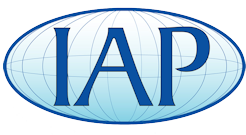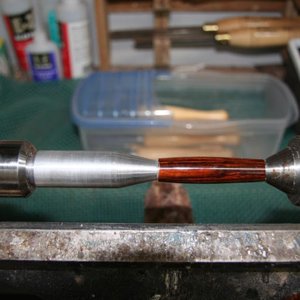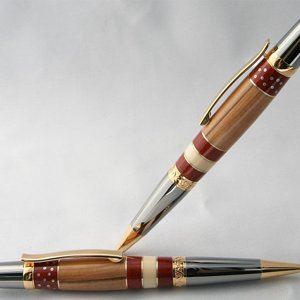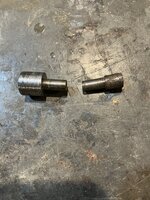I've recently come across a slimline kit that seems to have a "smaller" diameter center band than I can safely turn down to match. I see and hear a LOT about "TBC" set ups, and I do have those as seen in the photo. This still does not bypass the bushings however, so other than not bending the traditional pen mandrel, I see no beneficial use as far as getting below the bushings.
If I attempt to go below the bushings, it creates a "valley" at the end of the tube. I use carbide turning tools as I can't see the huge expense in traditional turning tools at this time. So the following questions arise.
I do have 60 degree dead and live centers but they tend to cone the tubes no matter how much pressure I use so I don't use them. The photo below is what I mainly use but bushings are still needed unless there's a trick to them.
1. Stop making slimlines
2. What other TBC systems are there that don't rely on bushings at all
3. Or just not use this style of kit anymore. ( I do like the design)
4. custom turned bushings. Don't have a metal lathe nor do I know anyone who does.
Thank you.
TBC set I have:
View attachment 382794
TBC, that picture of the TBC in your post is a good revision of the original TBC, but is a more expensive and to some extent does not do what the original TBC did.
The original TBC on IAP:
Imported Photo from leehljp. Please edit title and description.
www.penturners.org
The followup TBC photo on IAP using 60° centers:
Custom Bushings on TBC setup
www.penturners.org
As can be seen, the original was not 60° but the 60° does work better. The original purpose was to eliminate the problems with separating the bushing from the turned blank after a thick layer of CA had built up over the blank and bushing where they connect. On Oily Wood blanks, separating the blank from the bushing will OFTEN cause the CA to lift up off of the oily wood and have a cloudy look.
That said, bushings on TBC are used to turn to near size (by most people) and then removed for final sizing (using measurements with calipers) and finished (CA?) applied that way. It is then easier to remove the blank from the 60° cones than from glued on bushings.
The photo in your posting shows a bit of a mandrel onto which bushings are placed. 60° cones (live center and dead drive) serve the same purpose, but without the small shaft. That TBC? set in your photo did not come out until about 7 to 8 years after the original TBC method. IF one has a normal 60° live center on the tail stock, then only a 60° dead drive priced at around $10 at Amazon is all that is needed to begin TBC.
",
so other than not bending the traditional pen mandrel, I see no beneficial use as far as getting below the bushings."
IF one has spent time putting blanks on and taking them off of a mandrel, and doing this a couple of times to examine the turnings; and for me, taking a blank off of a mandrel and dropping and chasing a spacer on a regular basis, - the time it takes to do this is considerably longer than doing a simple (original TBC) "blank and bushing" take off of the lathe to examine it closely and then replacing it - there is a full minute difference to me between using TBC vs mandrel. Since I use calipers for measuring, I can measure more accurately holding the blank in my hands than I can leaving it on the lathe and mandrel. Measuring on the mandrel on the lathe does require one to shift to the correct position to hold the calipers totally perpendicular to the blank to get a precise measurement - especially when measuring to 1/1000 or even 2/1000 of an inch.
I can take a blank off in 2 seconds, take the bushing off in another second and begin inspecting and then measuring accurately, after that replace the bushing in 1 second and 3 seconds back on the lathe and have the tail stock up tight and ready to go. With a mandrel, in addition to the TBC time, one has to spend 3 to 5 seconds unscrewing the brass round nut, taking the spacers off (and chasing the one you dropped accidentally) then doing the same as one with TBC and then replacing with spacers back onto the mandrel, screwing the brass nut back on, putting it back onto the lathe and making sure the tail stock is tight enough but not too tight.
While there may not be more than 1 to 2 minutes difference, there is still a half a dozen extra steps to accomplish the same thing with using a mandrel. To some people, that isn't much, but to some of us, those extra steps are seen as totally unnecessary.
Lastly: "
I use carbide turning tools as I can't see the huge expense in traditional turning tools at this time. "
The carbide turning tools have been huge boon to those who do not have sharpening tools or experience need to properly sharpen an HSS tool. That saved the new turner a lot of money and time.
However, even with the best and finest of commercially available carbide inserts, IMHO, these best carbide inserts do not match the sharpness of good HSS tools properly sharpened. I see many times people's discussions on sandpapers (SP) and use of sandpaper. I still use SP on occasion but by and large, a well sharpened HSS will turn stabilized wood and smooth grained hardwoods so smooth that sanding is not always necessary. In fact if one does segments with metal (aluminum, brass or copper spacers) sanding causes so much smearing that it is almost impossible to remove the smearing completely. The only recourse is an extra sharp tool, (and HSS to me) does the best. I have done this often. I don't get quite the smoothness out of carbide inserts that I do out of my HSS tools. The down side is that HSS tools have to be honed or stropped a few times during a finishing process. That takes me about 4 to 6 seconds about once every minute of turning. The results though is no sanding is needed.
Elegant Beauty TI Gold Bloodwood, BOW, Holly core solder CA finish
www.penturners.org
No sanding on the wood or brass, and that was 16-17 years ago. Therefore No Sanding means smearing of the brass or solder dots, which smeared tremendously during sanding. HSS tools with a proper sharpening can do things inserts can't.






